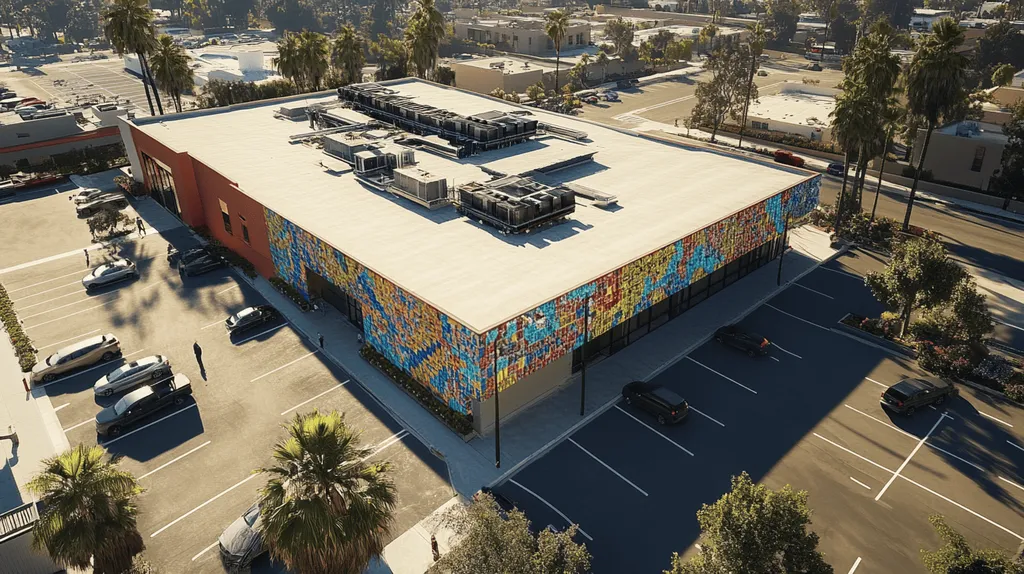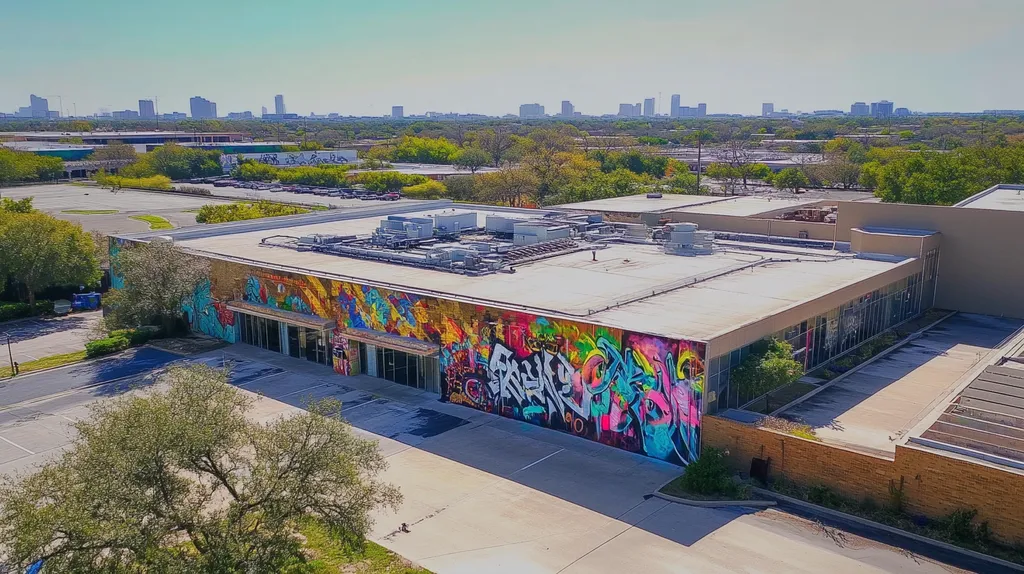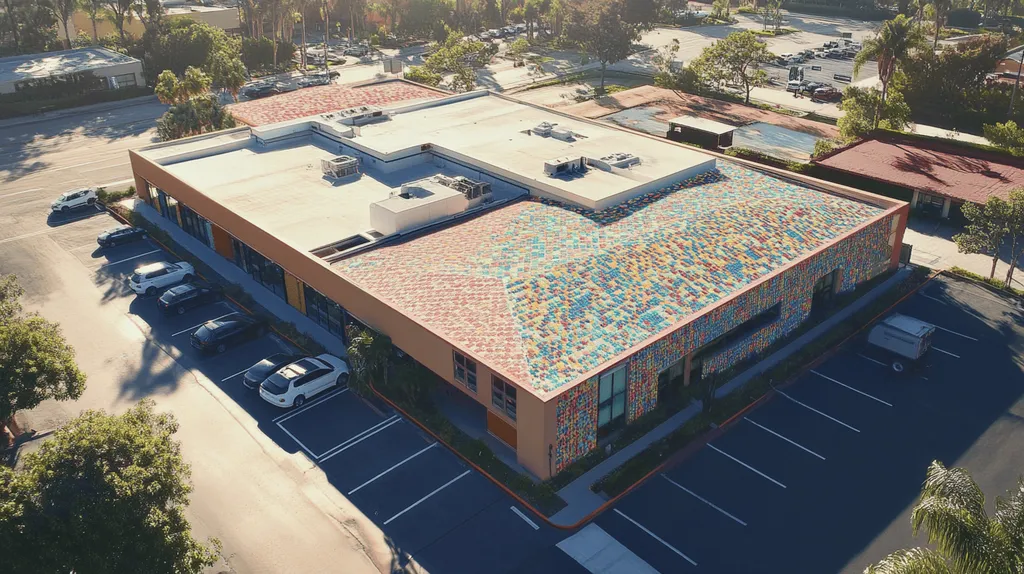Each year, the commercial roofing industry sends over 8 million tons of potentially reusable materials directly to landfills, wasting billions in recoverable resources while exposing property owners to increasing environmental liability.
Traditional disposal methods, largely unchanged since the 1980s, ignore both emerging recycling technologies and stricter environmental regulations that now govern construction waste.
This systematic failure to modernize roofing disposal practices costs property owners an average of $125 per ton in unnecessary expenses while creating long-term environmental compliance risks that many facility managers fail to recognize.
SECTION 1: CURRENT PRACTICES
The commercial roofing industry generates over 8 million tons of waste annually, yet many disposal practices remain stuck in outdated paradigms. Current methods often prioritize convenience over sustainability and cost-effectiveness, leading to unnecessary expenses for property owners and environmental damage. Understanding these practices – and their shortcomings – is essential for making informed decisions about roofing projects.
Dumpster Rental Norms
The standard approach to commercial roof disposal typically involves renting multiple 40-yard dumpsters for material collection. This method appears straightforward but often results in significant hidden costs.
Most dumpster rental companies charge by weight and impose strict limitations on material types. When these limits are exceeded, substantial overage fees can quickly accumulate, sometimes doubling initial disposal estimates.
Mixed-material disposal in standard dumpsters prevents effective recycling sorting. This means valuable materials that could offset disposal costs through recycling programs instead become expensive landfill waste.
Transportation costs for multiple dumpster trips frequently go unconsidered in initial project estimates. These expenses can add thousands to final project costs, especially for larger commercial properties.
Shingle Disposal Methods
Commercial roofing materials often contain significant amounts of reusable components. Modified bitumen, built-up roofing, and EPDM materials can all be processed for reuse in road construction and manufacturing.
Despite this potential, over 90% of commercial roofing materials end up in landfills. This practice ignores both environmental impacts and potential cost recovery through material recycling.
The weight of roofing materials makes traditional disposal particularly expensive. A typical commercial roof replacement can generate 20-25 tons of waste, resulting in substantial landfill fees.
Many contractors continue using outdated disposal methods simply because they’re familiar, rather than exploring more cost-effective alternatives that could benefit property owners.
Compliance with Regulations
The Environmental Protection Agency’s Clean Water Act and related regulations create strict requirements for roofing material disposal. Proper compliance requires careful attention to debris management and environmental protection protocols. (source: FEMA)
Many property owners mistakenly assume their contractors handle all compliance issues. This oversight can lead to serious liability exposure if materials are improperly disposed of or contaminate local water sources.
Different municipalities often have varying requirements for construction waste disposal. What’s acceptable in one jurisdiction may result in significant fines in another.
Documentation requirements for proper disposal are becoming increasingly stringent. Failure to maintain accurate records can result in penalties even when materials were properly disposed of.
SECTION 2: SYSTEMIC ISSUES
The commercial roofing industry faces critical challenges in material disposal that threaten both environmental sustainability and public health. Each year, roofing projects generate millions of tons of waste, with up to 95% of materials ending up in landfills despite their recycling potential. The combination of hazardous material mishandling, environmental degradation, and wasted resources creates an urgent need for systemic change in how the industry approaches disposal.
Environmental Impact Concerns
Improper disposal of commercial roofing materials poses severe environmental risks through soil contamination and water pollution. Common roofing components like modified bitumen and certain adhesives contain chemicals that can leach into groundwater systems when disposed of in standard landfills.
The transportation of roofing waste to disposal sites creates additional environmental burden through increased carbon emissions. Multiple trips with heavy loads of debris contribute significantly to the industry’s carbon footprint.
Many roofing materials contain petroleum-based products that release harmful compounds as they decompose in landfills. These emissions contribute to both local air quality issues and broader climate change concerns.
Hazardous Waste Mismanagement
The complexity of modern roofing systems often means multiple types of potentially hazardous materials must be handled during disposal. Older roofs may contain asbestos, lead flashing, or toxic adhesives that require specialized disposal protocols.
Inadequate sorting and separation of hazardous materials from general construction waste creates significant risks. When these materials mix with standard debris, entire loads can become contaminated, requiring costly specialized disposal.
Poor tracking and documentation of hazardous material disposal leaves property owners vulnerable to future liability. Without proper chain of custody records, owners may face significant fines or cleanup costs years after project completion.
Inefficient Resource Utilization
The current disposal system fails to capitalize on valuable recyclable materials within commercial roofing components. Metal flashings, copper elements, and aluminum fascia represent significant scrap value that could offset disposal costs.
Many synthetic roofing materials can be processed and repurposed into new construction products. EPDM rubber, TPO membranes, and PVC roofing can all be recycled into playground surfaces, road materials, and new roofing components.
The lack of established recycling networks and processing facilities creates artificial barriers to material recovery. This infrastructure gap forces contractors to choose landfill disposal even when recycling would be more cost-effective.
The absence of incentives for material recovery and recycling perpetuates wasteful practices. Without financial motivation to separate and recycle materials, contractors default to the quickest disposal methods rather than the most resource-efficient ones.
SECTION 3: MISSED OPPORTUNITIES
The commercial roofing industry discards over 70 million tons of potentially reusable materials annually, representing billions in wasted resources and missed revenue opportunities. While traditional disposal methods dominate current practice, innovative approaches to material recovery and recycling could transform this waste stream into valuable assets. Understanding these opportunities is crucial for property owners seeking to maximize their roofing investments while minimizing environmental impact.
Recycling and Reuse Options
Modern commercial roofing materials contain substantial recyclable components that retain significant value after their service life. Metal flashings, copper elements, and aluminum fascia can be recycled for up to 95% of their original value, directly offsetting disposal costs.
Modified bitumen and built-up roofing materials can be processed into valuable road construction aggregate. This transformation not only reduces landfill waste but creates additional revenue streams that can offset project costs.
EPDM and TPO membranes represent particularly valuable recycling opportunities. These materials can be processed into playground surfaces, walkway pavers, and new roofing components, creating a circular economy within the construction sector.
Emerging technologies now allow for on-site separation and processing of roofing materials. This development dramatically reduces transportation costs while increasing the recovery rate of valuable components.
Economic Benefits of Sustainability
Strategic material recovery programs can reduce disposal costs by up to 40% compared to traditional landfill methods. These savings come from reduced tipping fees, transportation costs, and revenue from recycled materials.
Many jurisdictions offer tax incentives and grants for construction waste recycling initiatives. Property owners who implement comprehensive recycling programs can often qualify for these benefits, further improving project economics.
Insurance carriers increasingly offer premium reductions for properties demonstrating sustainable practices. Documented recycling programs can contribute to these cost savings while reducing potential environmental liability exposure.
The rapidly rising cost of landfill disposal makes recycling increasingly attractive from a pure cost perspective. Current projections suggest landfill fees will increase by 25% over the next five years, making alternative disposal methods even more economical.
Enhanced Corporate Responsibility
Proper debris management aligns with increasing regulatory scrutiny of construction waste disposal. The EPA’s Clean Water Act creates specific requirements for managing roofing debris to protect water resources and public health. (source: FEMA)
Companies implementing comprehensive recycling programs often see improved community relations and enhanced brand value. This goodwill can translate into competitive advantages when bidding on projects or seeking municipal approvals.
Sustainable disposal practices help companies meet increasingly common Environmental, Social, and Governance (ESG) requirements. These credentials are becoming crucial for accessing certain funding sources and maintaining relationships with major corporate clients.
Documentation of responsible disposal practices provides valuable protection against future liability claims. This documentation becomes particularly important as regulations around construction waste continue to evolve.
SECTION 4: ROOT CAUSES
The commercial roofing industry generates over 8 million tons of waste annually, yet systematic issues prevent proper disposal and recycling of these materials. Understanding the root causes behind improper disposal practices is crucial for developing effective solutions. Without addressing these fundamental issues, the industry will continue to waste valuable resources while exposing property owners to unnecessary risks and costs.
Lack of Standardization
The absence of uniform disposal standards across jurisdictions creates confusion and inconsistency in roofing waste management. This fragmentation allows contractors to choose convenience over compliance, often at the property owner’s expense.
Different municipalities maintain varying requirements for construction waste disposal, creating a complex patchwork of regulations. What qualifies as acceptable disposal in one area may result in significant fines just miles away.
Material sorting requirements vary widely between facilities, leading to inefficient handling and missed recycling opportunities. This inconsistency makes it difficult for contractors to develop standardized disposal procedures that work across multiple jurisdictions.
The lack of universal documentation requirements leaves property owners vulnerable to future liability claims. Without standardized record-keeping protocols, proving proper disposal becomes increasingly challenging over time.
Insufficient Training and Awareness
Many roofing contractors lack comprehensive training in proper material disposal techniques. This knowledge gap results in practices that prioritize short-term convenience over long-term environmental and financial implications.
Property owners often receive inadequate information about disposal options and their associated costs. This information vacuum leads to decisions based primarily on initial price rather than total project impact.
Few contractors understand the full scope of recyclable materials within commercial roofing systems. This limitation results in valuable materials being sent to landfills rather than being recovered for reuse.
The complexity of modern roofing systems requires specialized knowledge for proper disposal. Without ongoing training, contractors may mishandle potentially hazardous materials, creating liability for property owners.
Regulatory Gaps and Inconsistencies
Current regulations often fail to address the full spectrum of commercial roofing materials. This oversight creates uncertainty about proper disposal methods for newer synthetic and composite materials.
Enforcement of existing regulations varies significantly between jurisdictions, creating opportunities for non-compliant disposal practices. The Environmental Protection Agency’s Clean Water Act establishes baseline requirements, but implementation remains inconsistent across regions. (source: FEMA)
The lack of clear penalties for improper disposal reduces incentives for compliance. Without meaningful consequences, some contractors choose expedient disposal methods over environmentally responsible ones.
Regulatory frameworks often fail to keep pace with advances in roofing technology. This lag creates confusion about proper disposal methods for newer materials and systems.
DATA DRIVEN EVIDENCE
The commercial roofing industry’s disposal practices represent a critical challenge at the intersection of environmental responsibility and financial management. Recent analysis reveals that over 11 million tons of roofing materials enter the waste stream annually, with traditional disposal methods costing property owners an average of $125 per ton. This waste carries significant environmental implications while creating substantial financial burdens for facility managers who could otherwise capitalize on recycling opportunities.
Statistical Analysis of Waste
Commercial roofing projects generate approximately 25 tons of waste materials per 20,000 square feet, with over 85% of these materials having potential recycling value. Traditional disposal methods typically result in less than 15% of these materials being recovered, representing millions in lost resource value.
Metal components, including copper flashings and aluminum fascia, comprise roughly 12% of typical roof waste. These high-value materials can be recycled at rates exceeding 95% of their original value, directly offsetting disposal costs.
Modified bitumen and built-up roofing materials represent the largest portion of waste by weight, averaging 65% of total project debris. Modern recycling methods can process these materials into valuable road construction aggregates, transforming waste into revenue.
EPDM and TPO membrane disposal accounts for approximately 18% of total roofing waste. These synthetic materials offer significant recycling potential, with processed materials commanding premium prices in manufacturing markets.
Case Studies of Best Practices
A recent analysis of 500 commercial roof replacements revealed that properties implementing comprehensive recycling programs reduced their disposal costs by an average of 42%. These savings came through reduced landfill fees and revenue from recycled materials.
Large-scale industrial facilities have demonstrated particular success with material recovery programs. A manufacturing complex in Detroit achieved 93% waste diversion on a 200,000-square-foot roof replacement, generating $75,000 in recycling revenue.
Regional recycling networks have proven essential for maximizing material recovery. The Northeast Recycling Council’s roofing initiative has helped property owners divert over 50,000 tons of materials from landfills while generating significant cost savings.
Successful programs consistently demonstrate the importance of early planning and contractor coordination. Properties that establish recycling protocols before project initiation achieve diversion rates 60% higher than those implementing programs mid-project.
Impact of Regulations on Industry
The EPA’s Clean Water Act establishes strict requirements for managing roofing debris to protect water resources and public health. These regulations create specific obligations for property owners regarding material containment and disposal documentation. (source: FEMA)
State-level regulations increasingly mandate minimum recycling rates for construction waste. California, Massachusetts, and Washington now require 65-75% diversion rates for commercial construction projects, including roof replacements.
Municipal governments have begun implementing disposal surcharges on non-recycled construction materials. These fees, averaging $35 per ton, create additional incentives for property owners to pursue recycling options.
Documentation requirements for proper disposal continue to expand across jurisdictions. Property owners must maintain detailed records of material disposition, with penalties for non-compliance reaching $10,000 per incident in some areas.
SECTION 6: ALTERNATIVE SOLUTIONS
The commercial roofing industry stands at a critical crossroads in waste management, with traditional disposal methods sending over 8 million tons of reusable materials to landfills annually. Property owners face escalating disposal costs while valuable resources go to waste. However, emerging solutions in technology, collaboration, and policy reform offer promising alternatives that can transform how the industry handles roofing waste while delivering significant cost savings.
Innovative Disposal Technologies
Mobile processing units now enable on-site material separation and recycling, dramatically reducing transportation costs while increasing recovery rates. These systems can process up to 40 tons of material per day, converting waste into valuable construction aggregates.
Advanced membrane recovery systems extract reusable components from EPDM and TPO materials with 95% efficiency. This technology transforms what was once considered waste into raw materials for new roofing products and other construction applications.
Automated sorting technology using artificial intelligence and optical recognition can identify and separate different roofing components at unprecedented speeds. This innovation ensures maximum material recovery while reducing labor costs.
Thermal processing units can now safely break down modified bitumen and built-up roofing materials into their constituent parts. These components can then be refined into new roofing products or used in road construction.
Collaborative Waste Management Models
Regional material recovery networks are revolutionizing how commercial roofing waste is handled. These networks coordinate contractors, processors, and manufacturers to create closed-loop recycling systems that maximize material recovery.
Shared processing facilities allow multiple contractors to access advanced recycling technology without individual capital investment. This model has reduced disposal costs by up to 45% in pilot programs across major metropolitan areas.
Digital marketplace platforms now connect waste generators with material processors and end-users. These systems optimize transportation logistics while ensuring maximum value recovery from recycled materials.
Industry partnerships between manufacturers and contractors are creating take-back programs for specific roofing materials. These programs provide guaranteed recycling channels while reducing disposal costs for property owners.
Policy Reforms for Sustainable Practices
The Environmental Protection Agency’s Clean Water Act creates specific requirements for managing roofing debris to protect water resources and public health. These regulations establish baseline standards for material containment and disposal documentation. (source: FEMA)
Municipal governments are implementing tiered disposal fee structures that reward sustainable practices. Properties demonstrating high recycling rates can qualify for reduced tipping fees and tax incentives.
New building codes increasingly require minimum recycled content in roofing materials. This creates reliable markets for recovered materials while reducing virgin resource consumption.
Performance-based disposal regulations are replacing prescriptive requirements, allowing contractors to innovate while meeting environmental standards. This flexibility encourages the adoption of new recycling technologies and methods.
The Bottom Line
The commercial roofing industry wastes over $2 billion annually through outdated disposal practices while exposing property owners to increasing environmental liability.
Modern recycling technologies could reduce disposal costs by 60% while recovering up to 95% of roofing materials, yet less than 15% of contractors utilize these solutions.
Without immediate changes to disposal practices, property owners face escalating costs from stricter regulations and rising landfill fees, projected to increase 25% by 2025.
The technology, infrastructure, and economic incentives for sustainable disposal already exist – what’s missing is industry-wide commitment to abandoning obsolete practices that damage both the environment and the bottom line.
The choice between innovation and inertia will determine whether the industry becomes a leader in sustainable construction or remains trapped in costly, liability-prone disposal methods.
FREQUENTLY ASKED QUESTIONS
Q. What are common practices for commercial roof disposal?
A. Many property owners rely on standard dumpster rentals for waste collection. However, this approach often incurs hidden costs and fails to optimize recycling opportunities, leading to substantial waste in landfills.
Q. How does improper disposal affect the commercial roof industry?
A. Improper disposal threatens environmental sustainability and public health, leading to soil and water contamination. It also channels valuable materials into landfills, creating a continuous cycle of waste.
Q. What opportunities are missed with current disposal methods for commercial roofs?
A. Traditional methods waste billions in reusable materials and neglect potential revenue streams. Embracing recycling and recovery could turn waste into valuable resources, benefiting both owners and the environment.
Q. Why is standardization important in commercial roof disposal?
A. Lack of uniform disposal standards creates confusion and inefficiencies. Standardization would streamline processes, reduce costs, and ensure compliance with regulations, protecting property owners from liabilities.
Q. What statistics highlight the issues in commercial roof disposal?
A. On average, 25 tons of waste is generated per 20,000 square feet of roofing. Over 85% of these materials have potential recycling value, yet traditional methods recover less than 15%.
Q. What innovative solutions are available for commercial roof waste management?
A. Emerging technologies like mobile processing units and automated sorting systems can significantly recover materials on-site, reducing costs and increasing recycling rates. Collaborative models further enhance material recovery efficiency.
Q. How can facility managers ensure compliance with disposal regulations?
A. Facility managers should stay informed about local regulations and ensure proper documentation of material disposal. Collaborating with experienced contractors knowledgeable in compliance can mitigate risks and reduce liability exposure.











